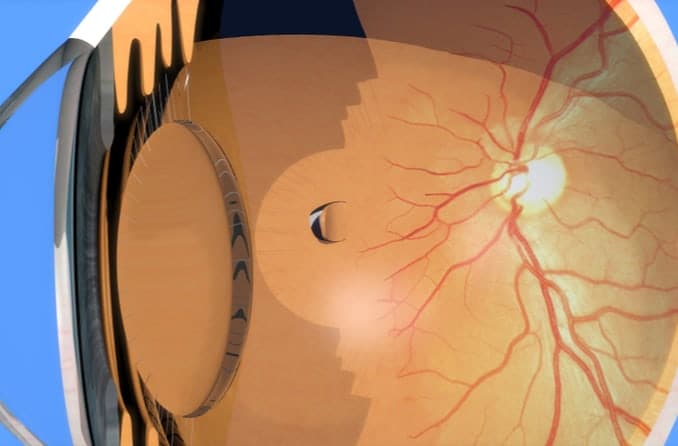What are eye floaters?
Eye floaters are tiny black spots in your vision. They are those spots, dots, specks, rings or “cobwebs” that drift aimlessly around in your field of vision. While annoying, eye floaters, also simply called floaters, are very common and usually aren’t cause for alarm.
Floaters develop in the clear, gel-like vitreous that fills the back chamber of the eye and which is responsible for giving the eye its globe-like shape. For this reason, eye floaters also are called vitreous floaters.
READ MORE: Types of eye floaters
What causes eye floaters?
Eye floaters are caused by irregularly shaped clumps of collagen that float around in the liquefied vitreous body, and can affect light passing through the eye. When they float close to the light-sensitive retina in the back of the eye, they cast shadows on the retina, and these shadows are what we perceive as eye floaters.
The vitreous body is mostly water, but it also contains a protein called collagen. As we age, the vitreous part becomes less like a gel and more watery. When this occurs, bits of collagen in the vitreous can clump together and form lint-like structures. These are what cause those squiggly lines in your vision.
When are eye floaters most visible?
You’re most likely to notice vitreous floaters when you gaze at a clear or overcast sky. They often appear in your peripheral vision, which makes it easy to mistake a floater for an insect flying in front of your face.
Another time people notice floaters is when they’re staring at a computer screen that has a white or light-colored background.
Once you start seeing floaters, it can be hard to ignore them, especially if you are stressed or fatigued.
Because the clumps of collagen that cause floaters are often suspended in the periphery of the vitreous, it can be impossible to look directly at them. When you move your eye to try and see better, the floater moves in the same direction and floats back into your peripheral vision and out of view.
When are eye floaters a medical emergency?
Noticing a few floaters from time to time is not a cause for concern. However, if you see a shower of floaters and spots, especially if they are accompanied by flashes of light, you should seek medical attention immediately from an eye care professional.
The sudden appearance of these symptoms can mean that the vitreous is pulling away from your retina, a condition called posterior vitreous detachment (PVD), or it could mean that the retina itself is becoming dislodged from the back of the eye’s inner lining, which contains blood, nutrients and oxygen vital to healthy function.
As the vitreous gel tugs on the delicate retina, it might cause a small tear or hole in it. When the retina is torn, vitreous can enter the opening and push the retina farther away from the inner lining of the back of the eye, and a retinal detachment can result.
In cases of retinal tear or detachment, treatment must occur as soon as possible so that an eye surgeon can reattach the retina and restore visual function before sight is lost permanently.
A study of 350 patients with PVD published in the journal Ophthalmology found that, of 163 patients who came to the clinic because of symptoms of just one or two floaters (with or without light flashes), a retinal tear developed in 12 of them (7.3%).
Based on this finding, if you suddenly develop large floaters, even if you don’t experience flashes of light, it’s a good idea to see your eye doctor immediately to make sure the floaters are no cause for concern.
SEE RELATED: Valsalva retinopathy
What causes vitreous detachment?
As mentioned above, posterior vitreous detachments (PVDs) are common causes of vitreous floaters. Far less commonly, these symptoms can be associated with retinal tears or detachments that may be linked to PVDs.
As the eye develops early in life, the vitreous gel fills the inside of the back of the eye and presses against the retina and attaches to the surface of the retina. Over time, the vitreous becomes more liquefied in the center. This sometimes means that the central, more watery vitreous cannot support the weight of the heavier, more peripheral vitreous gel. The peripheral vitreous gel then collapses into the central, liquefied vitreous, detaching from the retina (like Jell-O separating from the inside of a gelatin mold or bowl).
Eye floaters resulting from a posterior vitreous detachment are then concentrated in the more liquid vitreous found in the interior center of the eye.
It’s estimated that more than half of all people will have a posterior vitreous detachment by age 80. Thankfully, most of these PVDs do not lead to a torn or detached retina.
Light flashes during this process mean that traction is being applied to your retina while the PVD takes place. Once the vitreous finally detaches and pressure on the retina is eased, the light flashes should gradually subside.
What causes eye flashes?
Ordinarily, light entering your eye stimulates the retina. This produces an electrical impulse, which the optic nerve transmits to the brain. The brain then interprets this impulse as light or some type of image.
If the retina is mechanically stimulated (physically touched or tugged), a similar electrical impulse is sent to the brain. This impulse is then interpreted as a “flicker” of light.
When the retina is tugged, torn or detached from the back of the eye, a flash or flicker of light commonly is noticed. Depending on the extent of the traction, tear or detachment, these flashes of light might be short-lived or continue indefinitely until the retina is repaired.
Flashes of light (photopsias) also may occur after a blow to the head that is capable of shaking the vitreous gel inside the eye. When this occurs, the phenomenon sometimes is called “seeing stars.”
Some people experience flashes of light that appear as jagged lines or “heat waves” in both eyes, often lasting 10 to 20 minutes. These types of flashes are usually caused by a spasm of blood vessels in the brain.
If a headache follows the visual disturbances (including flashes of light), it is called a migraine with aura. But if the flashes occur without a subsequent headache, this is called an ocular migraine.
Photopsia also can be a symptom of digitalis toxicity, which can occur particularly in older people who take digitalis or related drugs for heart problems.
Other conditions associated with eye floaters and flashes
When a PVD is accompanied by bleeding inside the eye (vitreous hemorrhage), it means the traction that occurred may have torn a small blood vessel in the retina. A vitreous hemorrhage increases the possibility of a retinal tear or detachment.
Traction exerted on the retina during a PVD also can lead to development of conditions such as macular holes or macular puckers.
Vitreous detachments with accompanying eye floaters also may occur in circumstances such as:
Inflammation in the eye’s interior
YAG laser eye surgery
Diabetes (diabetic vitreopathy)
Inflammation associated with many conditions such as eye infections can cause the vitreous to liquefy, leading to a PVD.
When you are nearsighted, your eye’s elongated shape also can increase the likelihood of a PVD and accompanying traction on the retina. In fact, nearsighted people are more likely to have PVDs at a younger age.
PVDs are very common following cataract surgery and a follow-up procedure called a YAG laser capsulotomy. Months or even years after cataract surgery, it’s not unusual for the thin membrane (or “capsule”) that’s left intact behind the intraocular lens (IOL) to become cloudy, affecting vision. This delayed cataract surgery complication is called posterior capsular opacification (PCO).
In the capsulotomy procedure used to treat PCO, a special type of laser focuses energy onto the cloudy capsule, vaporizing the central portion of it to create a clear path for light to reach the retina, which restores clear vision.
Manipulations of the eye during cataract surgery and YAG laser capsulotomy procedures cause traction that can lead to posterior vitreous detachments.
SEE RELATED: Is it normal for young people with myopia to have eye floaters?
How to get rid of eye floaters
Most eye floaters and spots are harmless and merely annoying. Many floaters will fade over time and become less bothersome. In most cases, no eye floater treatment is required.
However, large persistent floaters can be very troubling to some people, causing them to seek a way to get rid of eye floaters and spots drifting in their field of view.
In the past, the only treatment for eye floaters was an invasive surgical procedure called a vitrectomy. In this procedure, some or all of the vitreous is removed from the eye (along with the eye floaters within it) and is replaced with a sterile clear fluid.
But the risks of a vitrectomy can outweigh the benefits for eye floater treatment. These risks include surgically induced retinal detachment and serious eye infections. On rare occasions, vitrectomy surgery can cause new or even more floaters. For these reasons, most eye surgeons do not recommend vitrectomy to treat eye floaters and spots.
Laser treatment for eye floaters
A less invasive laser procedure called laser vitreolysis is usually a much safer alternative to vitrectomy for eye floater treatment. In this in-office procedure, a laser beam is projected into the eye through the pupil and is focused on large floaters, which breaks them apart and/or frequently vaporizes them so they disappear or become much less bothersome.
To determine if you may benefit from laser vitreolysis to get rid of eye floaters, your eye doctor will consider several factors, including:
Your age
How quickly your symptoms started
What your floaters look like
Where the floaters are located
The floaters in patients younger than age 45 tend to be located too close to the retina and can’t be safely treated with laser vitreolysis. Patients with sizable eye floaters located farther away from the retina are better suited to the procedure.
The ophthalmologist who performs laser vitreolysis also will evaluate the shape and borders of your eye floaters. Those with “soft” borders often can be treated successfully. Likewise, sizable floaters that appear suddenly as a result of a posterior vitreous detachment often can be successfully treated with the laser procedure.
What happens during laser treatment?
Laser vitreolysis usually is pain-free and can be performed in your ophthalmologist’s office. Just prior to the treatment, anesthetic eye drops are applied and a special type of contact lens is placed on your eye. Then, the doctor will look through a biomicroscope (slit lamp) to precisely deliver the laser energy to the floaters being treated.
During the procedure, you might notice dark spots. These are pieces of broken up floaters. The treatment can take up to a half hour, but it’s usually significantly shorter.
At the end of the procedure, the contact lens is removed, your eye is rinsed with saline and the doctor will apply an anti-inflammatory eye drop. Additional eye drops may be prescribed for you to use at home.
Sometimes, you may see small dark spots shortly after treatment. These are small gas bubbles that tend to resolve quickly. There also is a chance that you’ll have some mild discomfort, redness or blurry vision immediately after the procedure. These effects are common and typically won’t prevent you from returning to your normal activities immediately following laser vitreolysis.
Your doctor will usually schedule follow-up for the following day. At that time, you may need a second treatment.
If you are bothered by large, persistent eye floaters, ask your eye doctor if laser vitreolysis might be a good treatment option for your situation.
Remember, a sudden appearance of a significant number of eye floaters, especially if they are accompanied by flashes of light or other visual disturbances, could indicate a detached retina or other serious problem in the eye. If you suddenly see new floaters, visit your eye doctor without delay.
READ NEXT: Asteroid hyalosis: causes, symptoms and treatments











